Year in the Orchard
Come tour through the seasons on the Freddy Guys hazelnut farm. Let us show you how we entice our marvelous trees to produce these delicious, nutritious treats for you and your family.
The Spring Orchard
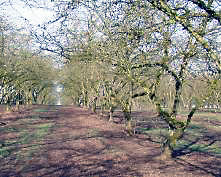
Spring in Oregon usually blows in with repeated Pacific squalls. It is the hardest time to convince yourself that you are not tired of the orchard, that you do want to be a farmer and that yes – it really is worth all this pressure that you're feeling. I think.
Bud swell – it's a tiny moment signaling a crushing cascade of events. As Uncle Ray says: "You need to get it all done, and all done right in the spring, and then the whole season will follow in an orderly manner. Mess up one spring job and you will pay for it all down the line."
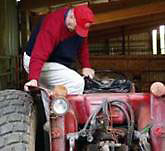
We often have as many family members as we can recruit in the spring. To be mowed properly all the chipping has to be first completed. Then the little kids run around with the gator and pick up cord wood, left at the base of the tree while chain-sawing. Toby runs the Kubota tractor with the brush rake looking for left over branches that missed the chipper. Evan fertilizes, using a small pull-behind spin spreader that holds 500 pounds for each run. All told, he spreads 18,000 pounds across 60 acres of orchard. We perform leaf and soil analysis each year to help with correct application.
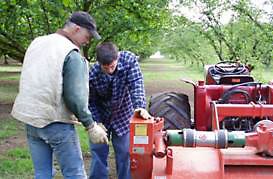
In early spring when the buds swell and the leaves first begin to unfold, we apply a fungicide to prevent Eastern Filbert Blight, a deadly fungal disease. We spray boron (same as 20 mule team borax in your laundry) in May, because the hazelnut tree picks up the elemental boron, and it helps nut-set (which will occur in about one more month). The nuts themselves never come into contact with these sprays. The orchard floor is carefully groomed in the spring, both by mowing with a flail mower and by dragging a wide heavy steel level across the orchard floor. These are slow, monotonous, and mind-numbing tasks. The result however, is very pleasing to the eye - the orchard floor is smooth and level in all directions, ideal for harvest.
The Summer Orchard
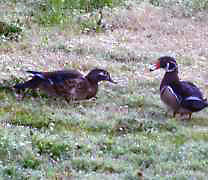
Each exhausting spring is followed by a more calm, almost balmy summer in Oregon and in the orchard. The work is more relaxing as well.
We are greeted regularly by the wood ducks who live along the Little Luckiamute river, which is nearby. They come at dawn and dusk to snuffle through the old leaves for insects. Fritz has counted many species of song birds that inhabit the arbors as well. Squirrels and rabbits inhabit the hedgerows. Red-tail and marsh hawks cruise the orchard in search of prey. Occasionally, a raccoon will be spotted sleeping high in a tree during the day. Bluejays throng to the orchard as the nuts mature in September. They spend most of the summer down the road at the blueberry patch in June and the cherry orchard in July.
In a mature and healthy hazelnut orchard the arbor is complete and dense meaning that very little light comes down through to the orchard floor. This is advantageous because it maximizes photosynthesis for the tree which improves productivity. It almost eliminates unwanted vegetative growth on the orchard floor.
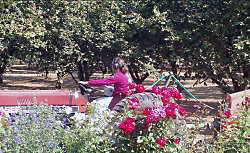
Summer work means putting on the headphones and listening to the radio while cruising along the rows with the water tanker and watering the baby trees. Sometimes I read my rose magazines as I roll slowly down the rows, stopping to water each baby tree. Oregon is damp enough that only the young trees, and only in the heat of summer, are vulnerable to drought stress. Hazelnuts are generally not an irrigated crop.
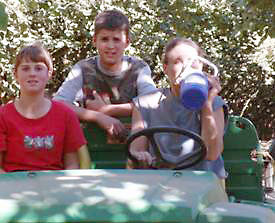
We also mow throughout the summer – approximately every 3 weeks. This keeps the grass down, continues to mulch the wood that we have chipped from that winters' cutting and helps to keep the ground smooth for easier harvesting.
The summer orchard is a good place to play. After dark it becomes the ultimate hide and seek arena for 10 year-olds who squeal with excitement when an evening breeze rustles the limbs and the coyotes are howling in the distance.
The Fall Orchard
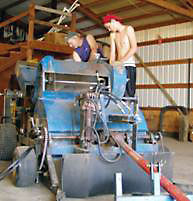
This is what it's all about – a year's worth of effort. It all comes down to the harvest, and you never know how it's going to turn out until the end – "it ain't over till it's over." Everything you do all year leads up to harvest, and as with most things, good preparation is key (along with some luck as far as the weather goes).
Late summer is a time of colder nights, shorter days, and intense midday heat. Hot days cause the outer husks to swell, cold nights cause contraction. These "dog days" at the end of summer eventually cause the nuts to drop – slowly at first and then in showers, especially if the day is windy. The leaves also begin to turn, then fall, but somewhat later than the nuts.
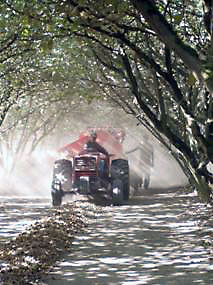
We watch, and worry, and get the equipment ready to go. All the belts and pulleys and gears are checked, cleaned, and replaced as needed. Two hundred empty totes are brought in, the diesel fuel tanks are filled. Two days before we begin we go around the entire periphery of the orchard and hand rake the "headers". This makes the row ends tidy so that the harvester is more efficient in these difficult spots.
Harvest begins in earnest before dawn when I go out at 5AM to begin sweeping. Each machine used in harvest is equipped with lights so we can work in the dark if necessary to get the job done during whatever window of opportunity the weather affords us. The sweeper scoots under the trees and windrows the nuts and leafy debris into the center of each row. Next, a tractor pulls the harvester right down the middle of each windrow and sucks up the nuts. The harvester is really a wind machine: It vacuums up the nuts and debris onto a belt where a series of wind chambers blows away the debris, and leaves the nuts to bobble along and fall into the empty tote bin, which is being towed behind the harvester on a small trailer.

Each tote box ( 4' x 4' x 4' ) can hold 1100 pounds and the harvester fills them fast enough that the tote hauler has a hard time keeping up with it. He uses another tractor equipped with forks to forklift each full tote off the harvester and runs them to the pickup area. He drops off an empty tote, runs with another full tote to the load-out area, and races back to the harvester with an empty. Occasionally we get in a traffic jam of rushing equipment and as Uncle Ray says "We just need to call 'er off here for a minute" That means take a break – I like to do that lying flat on my back with my eyes closed, listening.

We've never had a harvest that was easy, although we have gotten much better at it. We have struggled with older, less capable equipment and learned a lot. We now have newer upgraded and much more capable equipment – the right tools for the job. We experience a euphoric and satisfied sensation when the harvest is done. We've never had one that we weren't thrilled with by the time it was over. The orchard is a lot of work, but it has always given us a handsome return.
The Winter Orchard
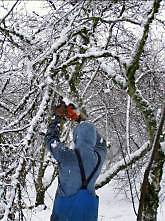
At our house winter's work really begins as soon as we know we are done with harvest, certainly before Thanksgiving.
First we decide which section of the orchard we will trim, and then how aggressive we need to be. Ideally each section should be cut back, cleaned out and reshaped every five years. If we divide our orchard into 5 sections we should be cutting about 1500 trees per year. We haven't made it yet! We bought the orchard in a state of significant neglect and we are not quite through the whole field (in 8 years). But what we've done looks really great!
Last year all we could do was clean up from a very damaging ice storm that hit in early January. We estimated 20% of the orchard was on the ground. Huge scaffolding branches from almost every tree dropped from the weight of a 2 inch ice ball that coated everything. We gave 20 cords of wood to the local wood share agency, gave about 15 cords to all the neighbors and kept about 5 cords for ourselves. It was overwhelming: Adam, Toby, Dane, Fritz and I chain-sawing four days a week for about 2 months removed only the large wood. The orchard was dotted with heaps of woodchips from the smaller branches which we fed into a wood chipper. Fortunately our dairy neighbor uses our excess chips in his out barns. He has several years' supply now.
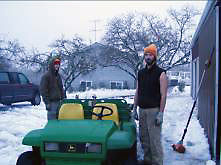
The other major winter job is our tree replacement program. Some babies go into "holes". These are areas where, due to neglect there just was no tree when we acquired the orchard. Those are easy to replace. A harder job is pulling an old tree that needs to be replaced for resistance reasons. The variety Daviana is particularly susceptible to Eastern Filbert Blight. We have replaced 80 percent of our vulnerable Davianas with several field varieties developed by Oregon State University. The two and three year old trees also need a little shaping in the winter. We have approximately 1500 blight resistant trees at this time.
Every January in Portland, hazelnut growers gather for the annual convention to discuss the years' events and hear about new developments in research, cultivation, marketing and how the crops in other countries are faring. We call it the nutball festival. All our fellow growers gather for a fun day to hear about new equipment and techniques, advances in field management, and an update on the status of the commodity markets. Did you know that Oregon hazelnuts are a global commodity? While we are doing this, our orchards are not asleep – they are busy pollinating! Hazelnuts pollinate by wind dispersal of pollen from December through February.